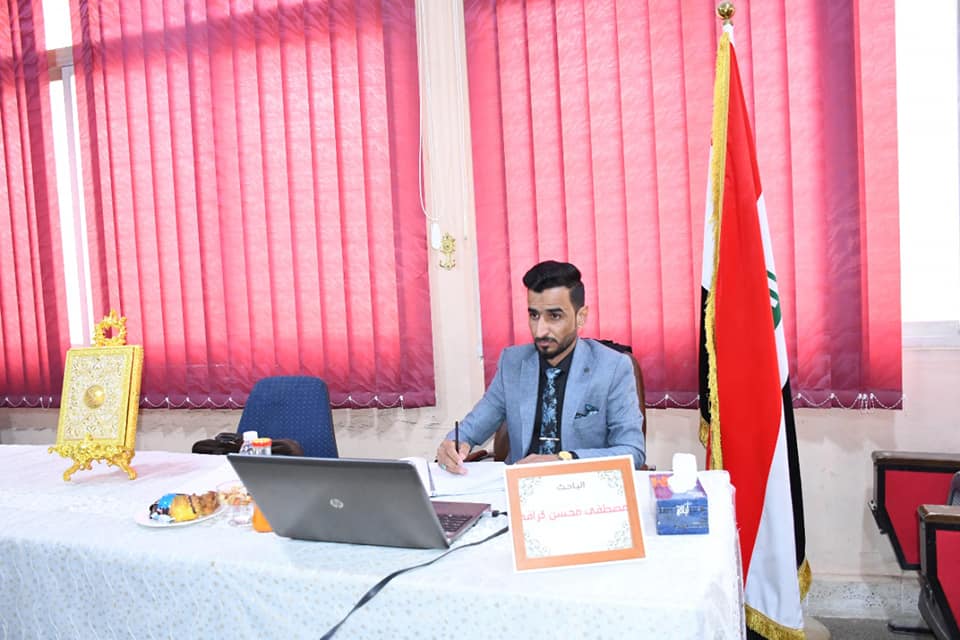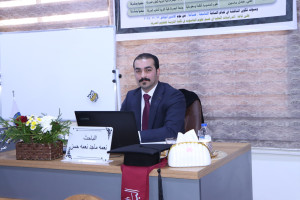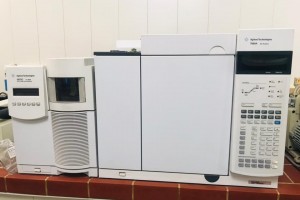
The College of Education for Pure Sciences, Department of Chemistry, discussed a master’s thesis on (preparation, diagnosis, and analytical study of some new Schiff bases, and the study of their effectiveness as antibody to MCF-7 human breast cancer).
The message presented by the researcher (Mustafa Mohsen Karafa) included
This study included four main axes, where the first axis focused on the preparation of the following new pharmacopoeial bases
While the second axis included the diagnosis of Schiff bases prepared using different techniques. Each base was diagnosed using infrared spectroscopy (FT-IR), and the results indicated the effective groups present in these bases that match the chemical formula of each. These rules were also diagnosed using the proton nuclear magnetic resonance (1H-NMR) technique, which showed the most important expected signals for the protons of the main groups that make up them. (A15), (A22) and (A24) which are nm(270), nm(275) and nm(280) respectively using ethanol as a solvent. These bases were also diagnosed using mass spectrometry, where the molecular ion peak (M/Z) of (A15), (A22) and (A24) appeared at (270, (480) and (452) and with a relative abundance of (100%) and (17.5%) and (100%) respectively, which agree with the theoretical molecular formulas for each base.
The third axis of this work focused on the analytical study of each rule of the prepared Schiff, and this axis is divided into two main parts:
• Study the effect of solvent
The UV-visible spectra of the prepared Schiff pharmaceutical bases were studied in a group of solvents of different polarity with a range of wavelengths (250-500 nm) in order to show the effect of these solvents on the displacement spectra of absorption spectra of the prepared Schiff bases. Its spectra showed three main absorption bands. The first beam refers to the transitions (-) of the aromatic system and the second beam refers to the transition between the () orbital localized on the central bond of the azomethine group -HC=N-)), while the third beam refers to the intermolecular charge transfer (CT) within a molecule Entire base lip. The relationship between the maximum wavelengths and the dielectric constants for each base was also calculated using different polar solvents, and the results confirmed the existence of a linear relationship, and this means that the dipole moment is what controls the displacement of the beams of the peaks belonging to these bases.
• Studying the effect of the acid function
The effect of pH on the electronic absorption spectra of the prepared bases in the ultraviolet-visible region, with a range of wavelengths (250-500) nm, was studied using a range of buffer solutions with different pH values, (12–2). From the results of this study, the ionization and protonation constants of the base (A24) were calculated using the mid-height curve method. The isobastic points of the base, the ionization mechanics, and the proposed protonation for them were also determined.
The fourth axis includes a study of both the biological and toxicological applications of the prepared bases, as follows:
The inhibition activity of the prepared Schiff bases against human breast cancer cells (MCF-7) was studied. The activity of each base was tested at a concentration of 125 µg/ml and for a period of (48) hours against these cells. The results showed that (A15), (A22) and (A24)) possess excellent toxicological activity against human breast cancer cells (MCF-7). The effectiveness of each base (A15, A22 and A24) has also been studied.
• The inhibition activity was also studied and the half-inhibitory concentration (IC50) of the prepared bases was calculated against human breast cancer cells (MCF-7), using different concentrations of (A15, (A22) and A24)) (31.25, 62.5, 125). , 250, 500, 1000) µg/ml for an exposure period of (48) hours. The results showed that the prepared Schiff bases had a strong effect on reducing the viability of growth and proliferation of cancer cells. The results also showed that the concentration of 1000μg/ml represents the inhibitory concentration and that the semi-inhibited concentration (IC50) of each of (A15), (A22) and A24) is equal to (1246.23 μg/ml) (492.31 μg/ml (1600.44). μg/ml) respectively for an exposure period of (48) hours.
This study also included a study of the effect of the inhibitory concentration on the growth of human breast cancer cells (MCF-7) and the shape and shape of the cancer cells when treated with six different concentrations of each of the prepared bases, (31.25, 62.5, 125, 250, 500, 1000 µg). /ml) for an exposure period of (48) hours.The results showed that each concentration will affect these cells in a different proportion compared to the concentration of the control solution (Control) and the death rate of human breast cancer cells type (MCF-7) increases with the increase in the concentration of each base.
Aim of the study
The aim of this study can be summarized in the following points:
And the preparation of some new rules of schiff unilateral and dual link.
Diagnosing the prepared compounds and studying their toxicity on human red blood cells.
And an analytical study of the rules of the prepared lip, and it includes:
Study the effect of organic solvents of different polarity on the absorption peaks of the prepared Schiff bases.
By studying the effect of the acid function on the prepared bases, calculating the ionization and protonation constants with different solutions, the pH function, determining the azobasic points and proposing their mechanics. And studying the effectiveness of the new Schiff bases as antidote to human breast cancer MCF-7 type, including the following:
Study of the efficacy of new Schiff bases against human breast cancer cells type MCF-7 .
Study of the effect of concentration on the inhibitory activity of breast cancer cells type MCF-7 .
Calculation of the IC50 inhibitory half-concentration of human breast cancer cells type MCF-7 .
Study of the highest effect of the prepared bases on the growth, shape and shape of human breast cancer cells MCF-7 type.








